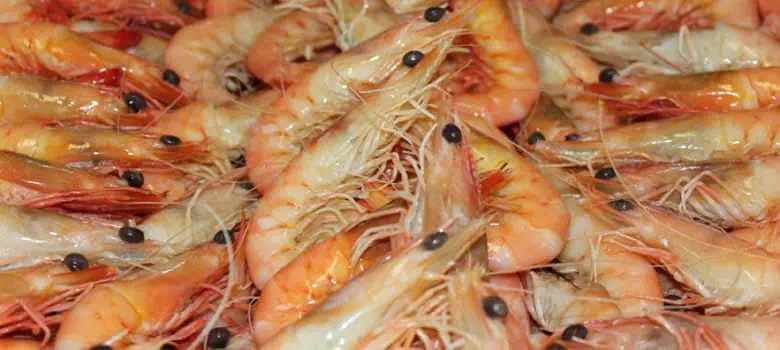Oysters and Prawns
Oysters and Prawns: When visiting seaside towns, eating fresh seafood is always a treat, and this trip was no exception. Earlier in the day, we had mentally noted the Big Oyster while driving around Port Macquarie and managed to get back just on closing time. We bought two dozen oysters and half a kilo of Yamba Prawns. We chilled down the oysters and then plated them with two big slices of lemon. We also had some at the Rivermark Cafe.
The Hasting Oysters are slightly salty and creamy with a slight mineral taste. The colour of the meat has a slight yellow hue. Shucked that day the oysters tasted great.
A dip and salad complement the cleanly shelled prawns. The oysters and prawns as a meal were simple and delightful.
 Oysters
Oysters
There are about 30 commercial oyster farms along the Hasting River around Port Macquarie, and only a few bother to harvest during winter months. Oyster farmers rely on rain like any farmer, and extended drought periods can turn the water salty and bring in many different species of plants and animals from the sea, which create problems for their industry. On the other hand, too much rain can mean no business. Growers cannot harvest after a certain amount of rain falls.
If you want your oysters, they can be collected from along the entrance rock break wall, wharf pylons and any place that is not a designated oyster lease. There is a bag limit of 50 per day, but beware, as oysters may be contaminated by pollution or naturally occurring algae. Eating contaminated shellfish can cause severe illness or death. Strict guidelines to safeguard public health govern commercially grown oysters.
Did you happen to know? Oysters are not fed or treated with any chemicals throughout their lifetime in the water or after harvest; A Sydney Rock Oyster will filter an estimated 0.25 ML of estuarine river water, with all NSW farmed oysters removing over 1 million tonnes of suspended material, mostly phytoplankton, in their lifetime; Most oyster species change sex during their life; An adult female oyster releases between 20 to 40 million eggs and a male, hundreds of millions of sperm at spawning.
Prawns
The King prawns we purchased at the Big Oyster came from the Clarence River region. This area is best known for its Eastern King Prawns or the famous Yamba prawn (Melicertus plebejus).
Australian consumption of prawns is about 30 000 tonnes a year, of which Australian commercial wild-catch fisheries provide around 50%. Imports from South-East Asia account for 40% of this demand, whilst the domestic aquaculture industry supplies the remaining 10%.
Unfortunately, in 2010 many of the Clarence prawn trawler operators had practically no income. For some reason, the prawns were tiny. Generally, on the Clarence, they catch prawns above 100 to half-kilo size. The prawns this year have been small, at about 200 to the half-kilo.
Yamba prawn trawlers have become a tourist attraction along with their fishy catches. They trawl the river, lake and ocean mostly at night. By early the following morning, their catches are for sale in fish shops and other outlets. By lunchtime, they are on the menu at many local restaurants.
“I’ve had big and small, cheap and dear, fresh and frozen, firm and soft, tasty and bland, prawns in my 51 years of enthusiastic consumption. But only a Yamba prawn delivers the best quality, quantity and price.” Mike Harvey – Elders Real Estate, Yamba.
Oysters and prawns – food fit for gods!



